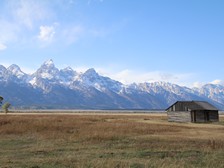You want to go on a road trip in Australia and/or New Zealand, but you don’t know how to plan it? Come on to have a look on my trip, on the itinerary I’ve followed and on my tips to get ready for yours.
GUIDES - AUSTRALIA & NEW ZEALAND: just down below, you can find city guides of the full itinerary:
Sydney: 4 days to visit Sydney and its surrounding area
Canberra: 2 days in Canberra
Melbourne: 3 days to explore the city of Melbourne
Auckland: 2 days to visit Auckland and its surrounding area
Wellington: 2 days in Wellington
TRAVEL BUDGET - AUSTRALIA & NEW ZEALAND :
Expenses of my 2 week trip to Australia and New Zealand


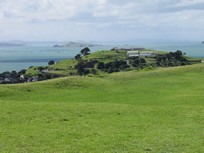
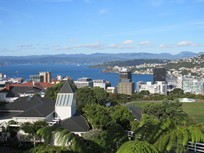
First, I think that when going to visit Australia, you should also consider going to visit New Zealand. It’s so far from everything that you should take advantage of visiting both countries on the same time. Even if we were told by the Australian customs officer that in New Zealand there are only « 10 sheep and 3 people », you should, for sure, go there to discover Maori’s culture and their amazing landscapes! (or if you are a huge fan of The Lord of the Rings)
That’s why I recommend planning a trip to both countries. And I think that you should stay at least 2 weeks to be able to visit all the main sights of Australia and New Zealand.
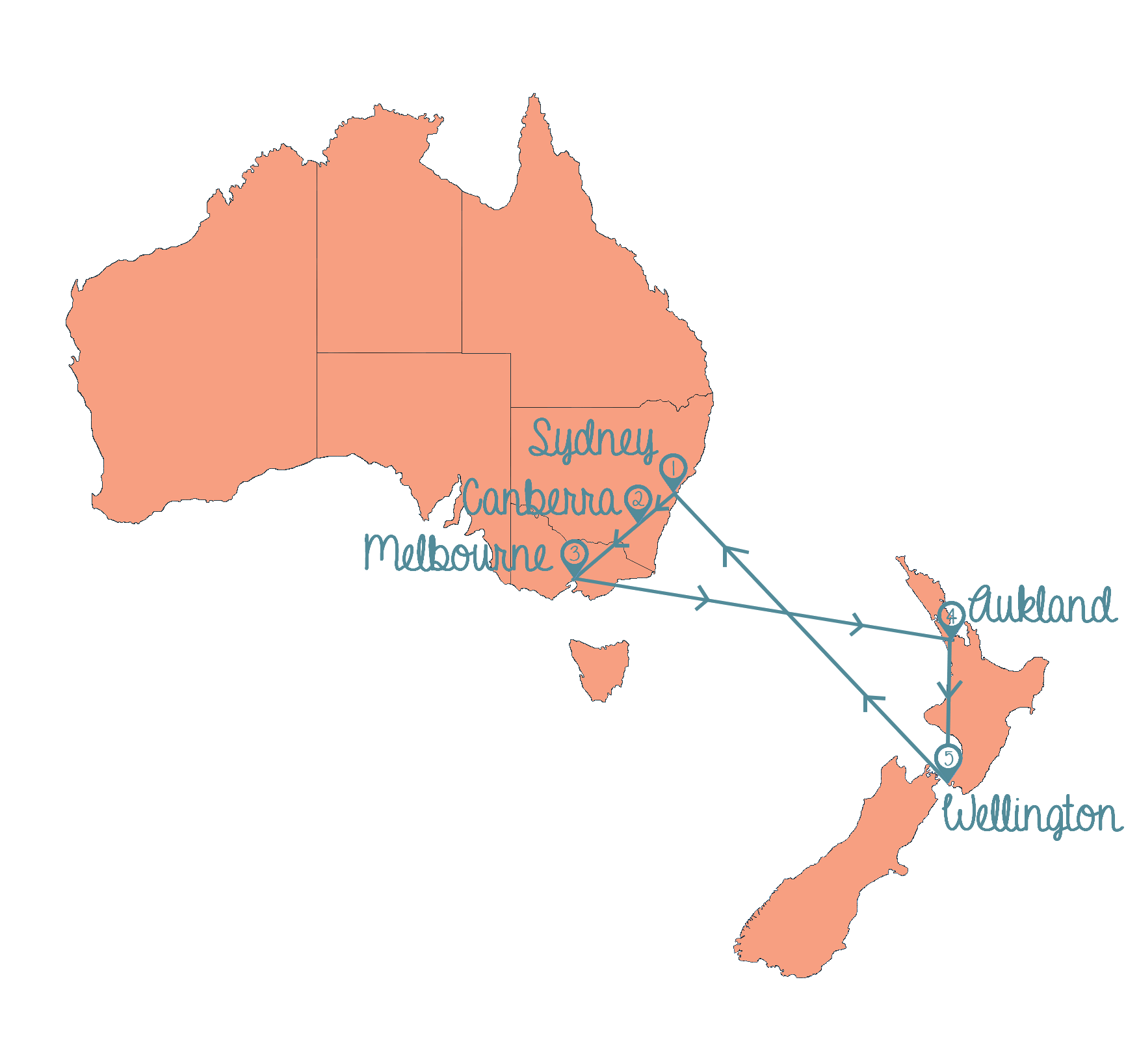
When to go?
Before starting planning your trip, it’s quite important taking in consideration the best moment to go. To visit south-east of Australia (especially the area between Sydney and Melbourne), the ideal moment is from December to February (even until March). But the best month to go is February because the students’ mid term break is over.
Planning
I have planned this trip to Australia and New Zealand in order to visit all the main sights, taking the least amount of time possible. But of course, you can stay longer if you have more time to spend there.
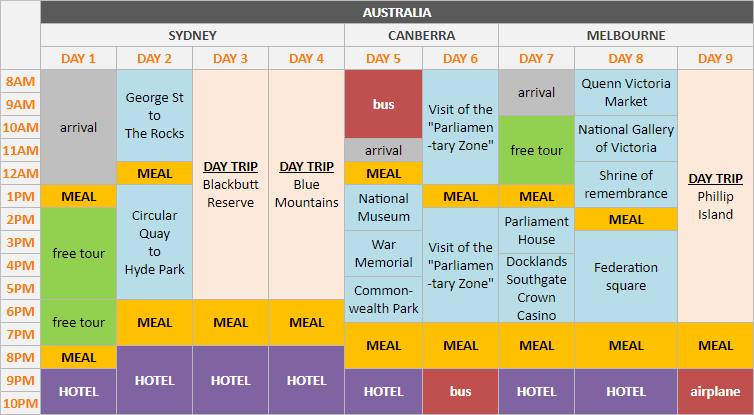
Start by visiting Sydney and stay there at least 4 days. Then take a bus to go to Canberra (there is only three and a half hours between the two cities) and stay there for 2 days, it’s enough. Then take an overnight bus (an 8 hours trip) to go to Melbourne. You should visit the city for at least 2 days, and staying one more day will allow you to go to see the Penguin Parade on Phillip Island.

Then, take an overnight flight (a three and a half hours trip) to go to New Zealand, and more specifically to Auckland, 2 days are enough to visit the city. Finally, take an overnight bus (an 11 hours trip) to go to Wellington and stay there for 2 days. And to finish, take a flight back to Sydney (a three and a half hours trip).
Tip 1: if you’re following this itinerary, I recommend choosing the company Greyhound to take the bus in Australia and to buy their AU$99 pass to be able to hop on and hop off whenever you want from Sydney to Melbourne. For the plane tickets, I recommend the airline Quantas because they allow carrying a 30kg luggage where Jetstar and Air New Zealand make you pay for that (the plane tickets of these 3 airlines are almost all the same price). To take the bus in New Zealand, you can choose the company InterCity which has low price tickets (NZ$31 for an Auckland/Wellington trip).
Tip 2: in Australia and New Zealand, almost all visit sights are free.
Tip 3: in New Zealand, in between the visits of Auckland and Wellington, you might also want to consider going to Rotorua to go to:
- Hobbiton: The Lord of the Rings Movie Set.
- Wai-O-Tapu: an active geothermal area (a kind of little Yellowstone).
- Mitai Maori Village: to have a glimpse into Maori culture.
Tips
Administrative part
Australia
To go to Australia, you’ll need a visa and a 6 month validity passport. The application is free for EU citizens and it’s valid for 3 months, but it can only be made online (electronic visa ETA). However, even if it’s free, it’s mandatory. To do so, you’ll need to go to the website « online.immi.gov.au/lusc/login ». Next, you must create an « ImmiAccount ». When it’s created, you can start your application. So fill in the required fields and when finished, they’ll send you your visa in your mailbox (at the e-mail address you have provided when you have created your account). The visa is the sheet of paper where the word « GRANT » is written. Normally you don’t need to take it to the airport because a record of your ETA is stored on your ImmiAccount, but I recommend taking it anyway. If you’re from another country, just go to the Australian Government website to check what kind of visa you need.
[UPDATE 2020] For EU citizens, it is no longer necessary to apply for a visa (ETA), a request for an eVisitor is enough. With the eVisitor, you can visit Australia as often as you wish in a 12-month period, for a stay up to 3 months each time. For the request, you must still go to the website « online.immi.gov.au/lusc/login » to create an « ImmiAccount ». For more information about the eVisitor, go to check the website « immi.homeaffairs.gov.au/visas/eVisitor ».
Canadian citizens and citizens of some other countries should apply for the electronic visa (ETA). The visa is free, but there is a AUD$20 service fee. For more information about the ETA, go to check the website « immi.homeaffairs.gov.au/visas/ETA »
If you’re from another country, just go to the Australian Government website to check what kind of visa you need.
New-Zealand
To go to New Zealand, French, Swiss, Belgian, but also citizens of 52 other countries don’t need a visa for a stay up to 3 months. You can go to check on the New Zealand Government website, if you need a visa or not.
[UPDATE 2020] To go to New Zealand, EU citizens and the citizens of many other countries don’t need a visa for a stay up to 3 months. However, it’s necessary to have an electronic travel authorization (NZeTA) which is valid for 2 years, and which allows multiple entries into New Zealand. An NZeTA request costs NZD$9 on the free app, or NZD$12 if completed online. NZ$35 must be added for the International Visitor Conservation and Tourism Levy (IVL).
You can go to check on the immigration website if you meet all the requirements to pretend to the NZeTA.
What to bring there
Adapter
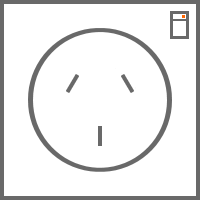
In Australia and New Zealand, wall sockets have 3 flat pins and look like British wall sockets. But they are not exactly the same because the top 2 flat pins are angled rather than straight. So be careful and don’t confuse!
Tip: over there, on electrical outlets there is always a switch, so when you are plugging a device in, make sure that the switch is on!
During your stay, you’ll really need an adapter. So I recommend buying one before going, that way you’ll be able to choose it (a cheap one, a convenient one …). But don’t worry, if you didn’t, you will still be able to find one over there. The cheapest you’ll find is at the 7-Eleven, it costs AU$8 and it’s a universal adapter. By the way, I also highly recommend bringing a triple socket, otherwise you’ll only be able to plug one device at the time (or you’ll need to buy several adapters).
Last thing to know, over there the voltage is 220V-240V, so if you are coming from North America or from Japan, more than an adapter, you’ll also need a voltage converter. But some devices like smartphones can use voltage from 110V to 220V. So read carefully what’s written on your devices and make sure you need one before buying a voltage converter.
Sunscreens
Australia and New Zealand are located right underneath the ozone hole, therefore, UV rays are very powerful there. So don’t forget to take sunglasses and a sunblock, especially if you have sensitive skin.
Money
Australian et New Zealand dollars
To get Australian and New Zealand dollars, there are, to me, 2 excellent ways:
- Global Alliance: if your bank is a member of this alliance, then you can withdraw cash at any of the cash withdrawal machine of the Westpac bank in Australia and New Zealand, with your credit card. They don’t take commission and have one of the best rate.
Tip: for example, the members are:
- Barclays in the UK
- Scotiabank in Canada
- Bank of America or Bank of the West in the USA
- BNP Paribas or Hello Bank in France
- Currency exchange offices: you can also carry some cash and go to change it over there (or even change it before going). And if you need money at the airport, just change what you need there, you’ll change the rest in town.
Coins and change
In Australia, the smallest coin is the 5 cents coin. But all the prices displayed are accurate, for example: AU$20.52. In that case, you’ll pay AU$20.55 and they won’t give you back your change. They always round up the prices to the next 5 cents. It’s the same thing in New Zealand except that the smallest coin is the 10 cents coin.
Advice
Customs
Try not bringing food or items made of animal skin to avoid troubles with customs. Because, or they’ll just ask you to throw it away, or they’ll also give you a fine. And they are very strict!
Opening hours
Try to get up early to start visiting, because at 5 pm, almost everything is closed. And some restaurants even close at 8 pm.
Internet
Most of the time, you’ll have to pay to get some Wi-Fi at your hotel. But you can often find free Wi-Fi at shopping centres or at libraries.
Restaurants
Over there, at restaurants, portions are pretty generous, so if there are different sizes available, I recommend taking the size S. Furthermore, tipping is not a common practice.
Hotels
Hotels in Australia and New Zealand are quite expensive, so youth hostels can be a really good alternative (and some have private rooms) especially if you don’t want to put all your money into accommodation.
In Australia, most of hotels and hostels charge for Wi-Fi and for the left-luggage service (about AU$6-AU$7/day).
Transportation
Plane tickets
Australia and New-Zealand are so far from everything, that going there is quite long and expensive.
Bus
The bus is one of the best means of transportation to move from city to city in Australia and New Zealand, because even if it’s slower than the plane it’s way more convenient. First of all, you won’t need to go all the way to the airport (which is often expensive), because the bus leaves directly from the city centre. And if you’re taking an overnight bus, you’ll also save a hotel night!
Tip: keep in mind that a 1 hour plane trip never really lasts 1 hour. Because you must arrive a few hours early at the airport, pass security, customs, claim your baggage and then find a way to reach the city centre from the airport!
In Australia, I recommend the Greyhound bus company for travelling across the country. They’ve got quite interesting passes (a kilometer pass and passes that allow unlimited stops between two cities) and cover the whole country unlike other companies. In addition, even if they have restrictions about luggage size and weight, they don’t check. And generally, on board, you have a USB socket to plug your devices and a Wi-Fi connection. To buy tickets or a pass, you can either do it via their website « www.greyhound.com.au » or directly at the bus station. In Sydney, I recommend « happy travels » which is a kind of backpackers’ travel agency. Some friendly young people will buy you the pass and can also help you booking your trips, because even if you have an unlimited pass, you must book your trips to be sure to have a seat into the bus, but don’t worry it can be change anytime. And they will print all your tickets to put them into a beautiful orange pouch. They do that for the exact same price as on the internet. I’d took the AU$99 pass to travel from Sydney to Melbourne via Canberra.
In New Zealand, I recommend the InterCity bus company for travelling from town to town, it’s really cheap (NZ$31 for a trip from Auckland to Wellington). However, the bus makes many stops which is quite annoying because people go up and down the bus the whole time. Also, I recommend booking your tickets in advance because the buses are filled really quick. I’ve booked mine one week in advance on the website « www.intercity.co.nz » and had NZ$4 fees, but you can also buy your tickets directly at the InterCity bus station.
Tip: if you are planning on taking the bus, I highly recommend bringing warm clothes or a blanket because onboard, the air condition is really high and you’ll probably get cold (some people even wear ski jackets!).
And just so you know, on a long trip the bus will stop on the way to let you to go to the toilets (even if there are toilets onboard) and to let you go buying some food.
Car
To me, renting a car to visit Australia and New Zealand is a bad idea. First, driving from city to city will you get you really tired, and once in town, you won’t necessarily need your car. Plus, you’ll need to find a place to park and it’s not sure that your hotel will provide free parking.
But if you really want to travel by car, be aware that you will need an international driving license and keep in mind that they drive on the left side of the road, which can be very disturbing. And last thing to know, even if car rentals are pretty cheap, returning the car in another city will triple the price!
Shopping, what to bring back home?
During a trip to Australia and New Zealand, you should buy some souvenirs:
- aboriginal’s or maori’s art: boomerangs and other trinkets
- real UGGS boots made in Australia
- wine, honey or macadamia nuts
- common souvenirs: key-rings, magnets, t-shirts, hoodies …
Thanks for reading :)




